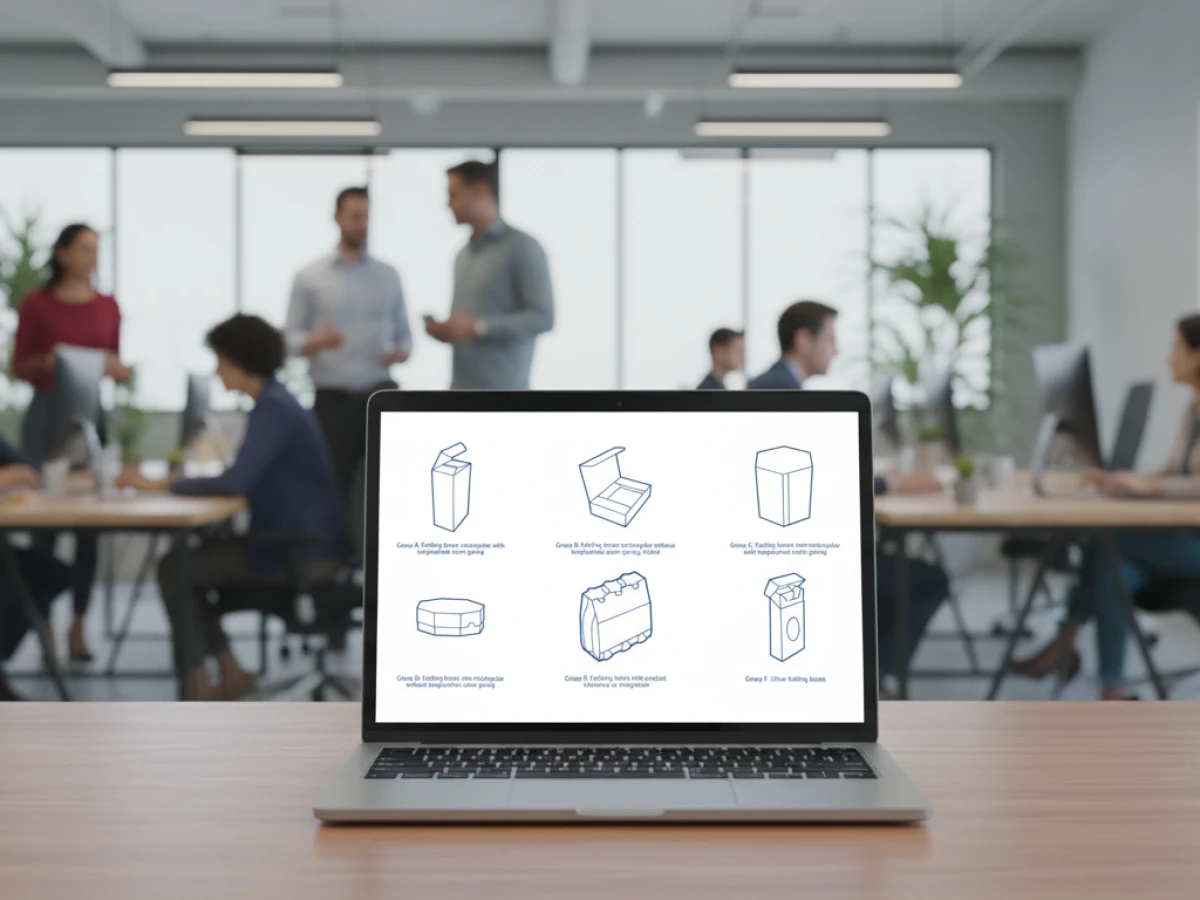FEFCO Standards: Mastering Corrugated Packaging in Web‑to‑Pack

FEFCO codes classify corrugated packaging and create a common language for developers, printers and brands. In web‑to‑pack systems these codes become dynamic templates that can be configured online, visualised in 3D and sent straight to production. The result: faster processes, fewer errors and more sustainable packaging.
Corrugated board as the backbone of modern trade
Corrugated board is the invisible backbone of modern trade. Whether you ship food, store electrical devices or design shelves in a supermarket – corrugated packaging ensures that products arrive safely. In the era of e‑commerce, just‑in‑time logistics and personalised deliveries, the demands on these packages are rising rapidly. Companies must not only produce reliably but also respond flexibly to different formats, contents and campaigns.
This is where the FEFCO code comes in: an internationally recognised classification system for corrugated packaging. Originally developed to replace complicated constructions with a clear numbering, it now forms the basis for automated packaging processes. Combined with web‑to‑pack solutions such as packQ, a rigid code becomes a dynamic tool that balances creativity, technical precision and speed.
This article explains what FEFCO standards are, why they are indispensable for the packaging industry and how modern software uses these norms to digitalise and automate the entire workflow – from configuration to production. We look at the structure of the FEFCO code, give examples of typical box types and describe how printers, brands and e‑commerce providers benefit.
Importance of corrugated board
Before we dive into the world of codes, it is worth looking at the role of corrugated board in everyday life. More than 40 % of all printed packaging worldwide is made from this material. This high market share has several reasons:
- Protection and stability: The combination of wave profiles and facings offers high strength with low weight. Products are protected from shocks and moisture.
- Flexibility: Different flute types (A, B, C, E, F) and material thicknesses allow packaging to be adapted to different loads and requirements.
- Printability: Corrugated board can be printed well. Full‑colour printing, coatings and finishes are possible to transport brand messages.
- Sustainability: As a paper‑based raw material, corrugated board is renewable and recyclable. Many manufacturers use recycled fibres, reducing the ecological footprint.
Thanks to these properties the range of applications extends from simple shipping cartons to product packaging and presentation displays. The challenge is to produce this diversity quickly, cost‑efficiently and without errors. That is exactly where the FEFCO code comes in.

What is the FEFCO code?
The Fédération Européenne des Fabricants de Carton Ondulé (FEFCO) – the European corrugated board association – developed a code system in the late 1960s to standardise constructions for corrugated packaging. The aim was to replace long and ambiguous descriptions and create a clear universal vocabulary.
Structure of the code
The FEFCO code consists of a four‑digit number. Each number describes a category and a specific design:
- The first two digits stand for the main category of the packaging type. Examples:
- 01: roll and sheet – packaging materials such as reels or sheets.
- 02: slotted boxes – the classic shipping cartons with top and bottom flaps.
- 03: telescope‑type boxes – a box consisting of two parts (base and lid) that slide into each other.
- 04: folders – fold‑up cartons used mainly for flat products such as books.
- 05: slide‑type boxes – components are pushed into channels or rails.
- 06: rigid type boxes – sturdy cartons with reinforced construction, often for heavy goods.
- 07: trays and inserts – open trays and containers, for example for fruit or bread.
- 08: displays and shelving systems – presentation displays, stands or retail racks.
- The last two digits specify the construction within the category. For slotted boxes (02) 0201 stands for the standard shipping carton where the flaps meet in the middle. 0215 has offset flaps. In category 07 0713 describes a tray with double‑wall sides and reinforced structure.
This logic covers several hundred box designs. A code such as FEFCO 0427 refers to a specially folded telescope carton often used for shipping.
Advantages of the FEFCO system
- International comprehensibility: The numerical combinations are identical worldwide, whether in Europe, North America or Asia. This makes communication between designers, manufacturers and customers easier.
- Time and cost savings: Instead of passing on complex instructions, specifying the code is sufficient. This saves time in design and procurement.
- Flexible adaptation: Although the basic construction is defined, dimensions such as length, width and height can be freely adapted. This creates a mix of standardisation and individualisation.
- Automation: Codes can be integrated into software. Web‑to‑pack systems access parameterised FEFCO templates and automate the calculation of panels, flaps, scores and material use.
FEFCO in web‑to‑pack software
With the advent of e‑commerce and personalised packaging, the need to digitalise the creation of corrugated packaging has grown. Web‑to‑pack solutions such as packQ integrate FEFCO codes as dynamic templates and automate the entire process. How does it work?
Parametric FEFCO libraries
Modern software contains more than 290 FEFCO models. Each model represents a code and contains all necessary data: fold lines, glue flaps, material thicknesses, permitted parameter ranges and notes on required areas.
When a user selects a template – for example 0201 for a standard carton – they can specify length, width, height as well as flute type (E, B, C, BC etc.) and material thickness. The system automatically calculates the required panels, fold zones and flap widths. Changes to the corrugation type are also taken into account because they affect folding and scoring parameters.

Workflow from selection to production
- Selection: The user browses the template gallery, where the FEFCO models are shown visually. Filters by category (shipping carton, tray, display) help with the search.
- Parameter adjustment: In addition to length, width and height, the flute type (A, B, C etc.) and board thickness can be defined. For special requirements double or triple wall flutes can be selected.
- 3D design: After dimensioning, the construction appears in the 3D viewer. Artwork (brand logos, patterns, colour areas) can be placed and changed. The software simulates the corrugated surface including wave structure and colour.
- Preflight and price: The system checks whether the graphic resolution, colour profiles and bleed are correct. At the same time the price algorithm calculates production costs depending on material, format, run length, printing process and finishing.
- Output: Once approved all data is generated – a PDF with the flat die line, a DXF file for cutting and scoring machines and 3D files (OBJ, GLB) for augmented reality or online presentations. All production data, including FEFCO code, material, flute type and dimensions, is transferred to ERP or MIS systems.
Thanks to this workflow the entire process from idea to production release takes only a few minutes. Previously a packaging engineer had to spend hours or days creating a CAD drawing, calculating parameters and conducting countless approvals.
Integration of additional functions
FEFCO‑based web‑to‑pack systems are often embedded in a broader range of functions:
- AI support: Tools such as the AI designer suite improve graphics directly in the browser. They vectorise logos, increase image resolutions (Crispify), remove backgrounds and create masks for finishing.
- Variable data: For personalised shipping cartons, serial numbers, QR codes, names or product information can be imported from databases. The software automatically places these variables in the designated position and generates PDF/VT files.
- Automatic preflight: During design, technical parameters such as resolution, colour space or text size are checked. The system immediately reports if a value does not meet the requirements.
- API integration: Order data and print files are transferred via interfaces to production machines. At the same time information such as stock levels or delivery times can be returned from ERP systems.
Examples of common FEFCO codes and their application
FEFCO 0201 – the classic shipping carton
Code 0201 stands for a standard slotted carton with overlapping lid and bottom flaps. This box can be supplied flat and erected on site. It is ideal for e‑commerce shipping, warehousing and the transport of a wide variety of goods. Its popularity results from:
- Simple construction: The flaps are brought together in the middle and glued or sealed with tape.
- Economical production: It can be manufactured on many corrugated machines without special tools.
- Flexible adaptation: Dimensions can be defined via parameters without changing the basic type.
FEFCO 0427 – versatile telescope carton
0427 is a telescopic carton consisting of two interlocking parts. It is ideal for premium products, gift sets or items that require special protection. Advantages include:
- Adjustable height: Depending on the product size, the lid can slide further up.
- Stability: The double wall provides additional strength.
- Presentation: The packaging has an elegant opening mechanism and is suitable for the retail environment.
FEFCO 0713 – tray with double‑wall sides
0713 describes an open tray often used for food, drinks or non‑food items. Characteristics:
- Open top for easy access and presentation.
- Double‑wall sides increase stability, which is especially important for heavy or fragile products.
- Stackability: The trays can be safely stacked.
These examples show how the FEFCO code covers a wide range of applications – from simple shipping cartons to sophisticated displays.

Benefits for different target groups
Printers and converters
- Production security: Using standardised codes ensures that all fold lines, glue flaps and die lines are correct. Preflight checks detect problems early.
- Efficient production: Automatic generation of CAD files saves development time. Existing dies can be reused if they correspond to the same code.
- New business models: Web‑to‑pack allows printers to offer online configurators. Customers enter orders themselves, making small runs profitable.
- Scalability: Parametric FEFCO templates enable the processing of many small orders. Data flows seamlessly into MIS and machine controls.
Brands and product managers
- Fast campaigns: Launches, seasonal promotions or personalised packaging can be implemented in a short time without burdening production.
- Design control: 3D visualisations allow packaging to be reviewed and feedback given before costs are incurred.
- Global consistency: With FEFCO codes brands can ensure uniform shipping packaging worldwide. Integrating local sites into the process makes coordination easier.
- Sustainability goals: Thanks to optimised material use and the use of recyclable materials, the packaging’s carbon footprint can be improved.
E‑commerce providers and start‑ups
- Self‑service configurators: Platforms can automatically adapt package sizes to the product (e.g. FEFCO 0201 with variable height) so that no unnecessary void space occurs.
- Cost efficiency: Live prices provide transparency on material costs and allow different variants to be compared.
- Personalisation: Packaging can be printed with brand logos, shipping information and marketing messages without separate production processes.
- Logistics integration: Interfaces to fulfilment and shipping providers ensure smooth processes.
Technical details: flute types and material choice
An important element of corrugated board is the choice of flute profile. FEFCO models take these differences into account because they influence stability, weight and print quality:
- E‑flute (1.5 mm): Thin and fine, ideal for high‑quality packaging with detailed print images.
- B‑flute (3 mm): Universally applicable, provides good protection with moderate material use.
- C‑flute (4 mm): Robust, mostly for heavier products or transport packaging.
- BC‑flute (6 mm): Double wall of B and C, for particularly high loads.
Web‑to‑pack systems allow the flute type to be selected during configuration. Material thicknesses and score widths are automatically adjusted. Pricing takes the additional material use into account.
Sustainability and FEFCO
Corrugated packaging is considered sustainable, but digitalisation enhances this effect:
- Precise dimensioning: Parametric calculations make packaging so precisely sized that as little air as possible is transported. This reduces material consumption and shipping costs.
- Recyclable materials: FEFCO cartons are made from paper fibres that can be recycled multiple times. Many manufacturers offer FSC‑ or PEFC‑certified materials.
- Digital proofs instead of samples: 3D previews and augmented reality models replace physical samples, saving resources and energy.
- Tracking of carbon footprint: In future web‑to‑pack systems will calculate environmental metrics to support sustainable decisions.
Challenges and solutions
There are also pitfalls when using FEFCO standards:
- Complex custom designs: Not all customer requests can be covered with standard codes. Hybrid approaches help here: a CAD specialist creates a prototype, which is then integrated into the web‑to‑pack system as a parameterised template.
- User overwhelm: With more than 200 types, selection can be difficult. User‑friendly search and filter functions and visualisations make it easier to get started.
- Updating the standards: FEFCO regularly publishes new codes. Software providers must integrate these into their systems. Cloud‑based solutions can roll out updates quickly to all users.
- International norms: FEFCO is a European standard. In North America there is, for example, the RSC system (Regular Slotted Container). Modern platforms integrate multiple standards so they can operate globally.
Future trends and innovations
The world of corrugated packaging is constantly evolving. Current developments show where the journey is heading:
- AI‑assisted selection: Algorithms propose the optimal FEFCO type based on product dimensions, weight and shipping method.
- Augmented reality (AR): Customers can place their packaging virtually in the warehouse or on the sales shelf and adjust it.
- Smart packaging: Sensors and RFID chips are integrated into corrugated packaging to enable track‑and‑trace, temperature monitoring or interaction with end consumers.
- Automated material suggestions: Systems take sustainability criteria into account and propose environmentally friendly alternatives.
- Industrial 3D printing: Additive manufacturing enables small series of packaging components or individual inserts. FEFCO models could be integrated into such production processes.
The FEFCO code has revolutionised the world of corrugated packaging. By clearly classifying boxes and displays, it simplifies communication between design, production and customer. In times of increasing personalisation and digitalisation, this standard is more important than ever.
Web‑to‑pack solutions such as packQ elevate FEFCO to a new level: they transform rigid codes into flexible, parameterised models that can be adjusted online. This shortens development times, reduces errors and makes production more efficient. Companies benefit from fast, transparent processes and can implement both standard packaging and personalised campaigns without additional effort.
For printers this means higher utilisation, for brands better control and for the end customer a better experience. At the same time FEFCO standards contribute to sustainable packaging production because material is optimally used and recycling options exist.
The future will be even more exciting: AI, AR and intelligent materials expand the possibilities, while standardisation forms the basis for scalability. Companies that combine FEFCO with web‑to‑pack are pursuing a future‑proof strategy – fast, precise and sustainable.

FAQs
What is the FEFCO code?
The FEFCO code is an international standard for classifying corrugated packaging. Each four‑digit number describes a specific box type, for example 0201 for the classic shipping carton. This system replaces long descriptions and facilitates communication between designers, producers and customers.
How does FEFCO differ from ECMA?
FEFCO describes corrugated packaging, while ECMA classifies folding cartons made of board. FEFCO codes consist of four digits; ECMA codes consist of letters and numbers. Both standards are integrated into modern web‑to‑pack solutions and complement each other to cover the entire range of packaging.
Can I customise FEFCO boxes?
Yes. Although the code defines the basic structure, dimensions such as length, width, height and material thickness can be varied. Parametric models in web‑to‑pack systems automatically adjust all other elements to maintain technical functionality.
What advantages do FEFCO‑based web‑to‑pack solutions offer for e‑commerce?
Online retailers can configure shipping cartons precisely to their products. This saves material, reduces transport volume and improves the unboxing experience. In addition, variable data processing enables the personalisation of packaging for marketing purposes.
How is the FEFCO catalogue kept up to date?
FEFCO regularly publishes new editions of its catalogue, taking into account current market trends and new designs. Web‑to‑pack software providers integrate these updates automatically so users always have access to the latest codes.
Introducing our product features:
https://www.packagingdesignsoftware.com/feature/ecma-fefco-packq-box-library
https://www.packagingdesignsoftware.com/feature/corrugated-board
https://www.packagingdesignsoftware.com/feature/template-gallery
https://www.packagingdesignsoftware.com/feature/production-workflow



.webp)

